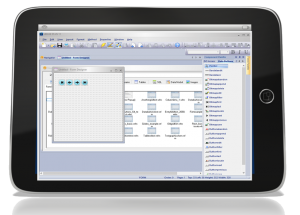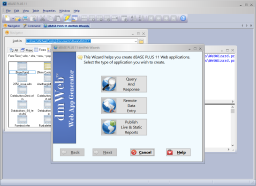
| NEW: Touch Screen | ||
|---|---|---|
 |
dBASE™ PLUS 11 introduces support for the latest touch interfaces with improved tablet support. | |
| NEW: dmWeb™ | ||
|---|---|---|
 |
The new dmWeb™ found in dBASE™ PLUS 11 introduces the new Skeleton CSS Responsive framework for generating industry standard Web Apps. http://getskeleton.com/ The completely updated Web Wizards now under the dmWeb™ moniker allows dBASE users to get running with surprising speed of taking data-driven applications to the web. | |
| Features in dBASE™ PLUS 10 |
|---|
| ListView | ||
|---|---|---|
 |
ListView is a brand new native data-aware dBASE component designed for efficient display of vertically scrolling lists of changing data. |
|
| Upgraded: Grid | ||
|---|---|---|
 |
We have added some small enhancements to the current Grid found inside dBASE. Things like highlighting the current cell focus and other cosmetic wants by the user community. |
|
| Bug fixes | ||
|---|---|---|
|
dBASE PLUS 10 is built on the quality of dBASE PLUS 9.5.1 and has continued to fix known bugs, and add, update, and replace features to make the product easier to use and give the users the ability to build cutting-edge Windows® based data-aware applications. |
||
| Additional Features in dBASE™ PLUS 10 |
|---|
| dLocator™ – Find in files functionality | ||
|---|---|---|
 |
Now allows for incremental search, faster search and replace, and also brings the Search in Files features to the product. |
|
| Code Hints – Help docs as quick as a mouse hover | ||
|---|---|---|
 |
The new editor will now display code hints to help people create code quickly with updated material from the documentation. |
|
| Code Folding | ||
|---|---|---|
 |
Code Folding: (lots of code, reduce the length and focus on only the code you need). |
|
| Line Numbers | ||
|---|---|---|
 |
Know the exact line number in the code |
|
| End of Line Indicators | ||
|---|---|---|
 |
Know where the line ends and how it was ended. The End of Line Indicators work in combination with White Space Indicators and Indentation Guides. |
|
| ADO Support – Connectivity | ||
|---|---|---|
 |
More has changed under the hood of dBASE PLUS than just support of Microsoft’s latest operating system. We have also added support for connecting to ADO datasets. |
|
| Build Options | ||
|---|---|---|
| Conversion Tools |
These are included tools to help migrate from prior releases of dBASE. |
|
| Build Web Application |
Specialized tools for building applications for the web. |
|
| Runtime Engine |
Allows dBASE application exe’s to be deployed and run on user’s workstations, servers, and web-servers. |
|
| Just-In-Time Compiler |
Compiles source code into a highly compact object code (also called “byte code”) either on demand or only when needed – prior to running it. |
|
| Integrated Debugger |
A debugger that has a graphical user interface inside of the development environment and is a used to test and debug other programs (the ‘target’ program). |
|
| Virtual Machine Interpreter |
A highly optimized interpreter for executing dBASE object code (byte code) that has been generated by the dBASE compiler. |
|
| Tool Features | ||
|---|---|---|
| Command Window |
The Command window is used to directly execute one-line dBL commands. It is handy for testing simple expressions and immediately seeing the results in the results pane. |
|
| Navigator |
The Navigator provides a visual way to create, locate, access, and open individual files. It also lets you establish your working directories and search paths. |
|
| Form Designer |
The form design window is a visual design surface on which you position the components you need for your form, then set their properties in the Inspector and code their event handlers and other methods. |
|
| Report Designer |
The report window is a visual design surface to which you drag and drop the components you need for your report, then set their properties in the Inspector. |
|
| Menu Designer |
Building basic menus through the designers is a simple two-step process of adding items, then adding code to make the items do what you want them to do. |
|
| Label Designer |
Use the Label designer to create labels and other reports that use more than one report band. |
|
| Source Code Editor |
The Source editor lets you view or edit code for any dBASE Plus form, report, menu, query, data module, program, or any other type of text file. |
|
| OLE / COM / ActiveX support |
3rd party libraries support for extending dBASE applications. |
|
| Data Manipulation | ||
|---|---|---|
| Table Designer |
Use the Table designer to design or restructure a table. |
|
| Data Module Designer |
The Data Module design window is a visual design surface for designing data modules that you can use in your forms, reports, and labels. |
|
| Data Access Classes(Session, Database, Query, Rowset, Field, StoredProc and Datamodule) |
A set of non-visual classes that make working with databases easier. |
|
| ODBC Support |
dBASE can interact with any ODBC (Open DataBase Connectivty) data source and manipulate its data. |
|
| Support for Native dBASE Tables (Levels 3,4,5 and 7) |
Supports all dBASE DBF table structures from level 3 thru level 7. |
|
| Support for Paradox Data |
dBASE can interact with Paradox data structures. |
|
| Support for FoxPro and Visual FoxPro Data |
dBASE can interact with FoxPro and Visual FoxPro data structures. |
|
| Customize Solution | ||
|---|---|---|
| Visual Object Classes |
A set of components that are visual in design and make creating Microsoft Windows applications fast and easy. |
|
| Operating System classes |
A set of components that allow for simple integration to the underlying Operating System items like the File System. |
|
| xBASE language support |
One of the first functional database programming languages that the dBASE product pioneered. |
|
| dBL (dBASE Language) |
dBL (dBASE Language) is an object Oriented language for building rich database applications in dBASE. |
|
| Local SQL |
Local SQL (sometimes called “client-based SQL”) is a subset of ANSI-92 SQL for accessing DB (Paradox) and DBF (dBASE) tables. |
|
[raw]
| Product Info |
|---|
| Product Overview |
| Features in Depth |
| System Requirements |
| Product FAQ |
|